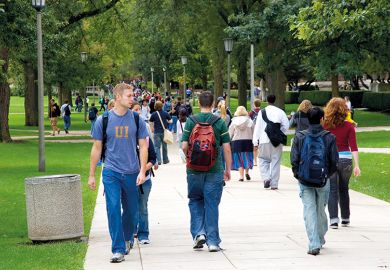The University of Alaska System is issuing staff-wide furlough notices and preparing for “devastating” lay-offs and course closures after the state’s governor imposed a 41 per cent cut in its budget support.
The governor, Michael Dunleavy, ordered the $135 million (£107 million) cut to the university system as part of more than $400 million in state spending reductions aimed at preserving a tradition of annual oil revenue-based payments to state residents.
The university and its advocates hope to convince Alaska lawmakers to reverse the cuts, though that would require a three-fourths vote against the Republican governor by a Republican-majority legislature.
Either way, the university system has no time to react, as Mr Dunleavy – after signalling various less-severe possibilities for months – imposed the cuts one business day ahead of the 1 July start of the state’s fiscal year.
The University of Alaska System president, Jim Johnsen, met with the board of regents in Anchorage on 28 June as the governor outlined the cuts in Juneau.
“There’s no question”, Dr Johnsen told the regents, “this budget, if not overridden by the legislature, would be devastating to the university and to our mission and to the state and to our economy now and for years to come.”
Mr Dunleavy portrayed his action as more benign. “It’s going to be tough for a short period of time here,” he told a news conference, “but we’re going to get through it.”
The University of Alaska System consists of main campuses in Anchorage, Fairbanks and Juneau, plus 13 separate community campuses. The Anchorage campus, with about 14,000 students, is the largest. Fairbanks, the flagship, is recognised as one of the world’s best small research institutions.
Mr Dunleavy took office last year largely on his promise to reverse the shrinking value of payouts from the Alaska Permanent Fund, which since 1982 has been handing state residents an annual dividend from oil-related revenues. The fund’s per-person payment had been around $2,000 per year, but shrank in recent years, largely because of sagging stock investments. The fund’s total value is now around $60 billion.
Announcing the budget cuts – which also included deep reductions to schools, healthcare, retirement benefits and more – Mr Dunleavy said he did not believe the University of Alaska should try to “be all things to all people”.
The university’s leadership can handle the challenge posed by the cuts, he said. “I believe that they can turn the university into a smaller, leaner, but still very, very positive and productive university here in the northern hemisphere,” the governor told the news conference.
University leaders, however, said the cuts were far too much, too fast, for a system that gets 40 per cent of its budget from state support. Unchanged, the budget cuts could mean 1,300 job losses across the system, university officials estimated.
Cathy Sandeen, chancellor of the University of Alaska at Anchorage, predicted the budget cuts, if not reversed by lawmakers, would lead to entire programmes being closed down, and an exodus of the educated from Alaska, harming the state’s economic competitiveness.
As a first step, Dr Johnsen said, all university staff are being given a 60-day notice of furloughs. The System is also imposing an immediate hiring freeze, an immediate travel freeze, and tight limits on any new vendor contracts, he said.
The System’s regents are due to meet the week of 15 July and consider a declaration of financial exigency. If that happens, even tenured faculty could be fired with just 60 days’ notice.
Register to continue
Why register?
- Registration is free and only takes a moment
- Once registered, you can read 3 articles a month
- Sign up for our newsletter
Subscribe
Or subscribe for unlimited access to:
- Unlimited access to news, views, insights & reviews
- Digital editions
- Digital access to THE’s university and college rankings analysis
Already registered or a current subscriber?







